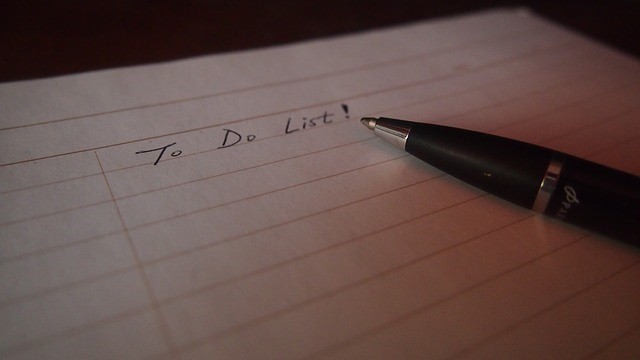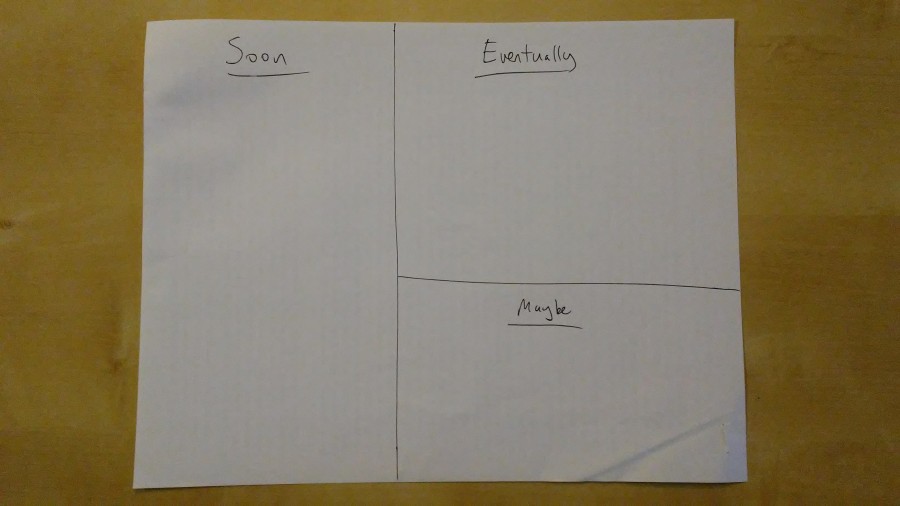
I have a problem with to-do lists.
Writing things down is a good idea, of course, but the basic to-do list is, well, pretty basic. The typical to-do list fails to differentiate between short-, medium-, and long-term objectives. It doesn’t distinguish between things you have to do today and things you’d merely like to do today. It also doesn’t distinguish between today and tomorrow, between this week, this month, and the distant future. It doesn’t prioritize. It’s just a list of things to do, thrown together at random.
I believe this classic productivity tool needs an upgrade, so I’m going to share with you a system that I’ve developed that takes the to-do list to a whole other level. To-do lists shouldn’t just be about remembering what to do. They should enhance your executive function by helping you plan ahead and use your time wisely.
The particulars of my system might not make sense for your life, but you can still use the principles behind its features to write better to-do lists in a way that does work for you.
My system has three levels:
- Daily Planning
- Weekly Planning
- Long-Term Planning

Daily Planning
For my daily to-do list, I use ¼ of a sheet of plain white paper. The small size is actually an important feature. I can only do so much in a day, and having a limited space to write down what I have to do forces me to prioritize. A half sheet or full sheet of paper has way too much room on it, which would allow me to overload today’s list. An electronic to-do list has no limit and is therefore even worse.
An overloaded list is a big problem because it encourages procrastination in two ways. Without the forced-prioritizing of a small list, I’d be likely to choose the easiest tasks on the list rather than the ones that actually need to get done today. I’d feel like I’m being productive while neglecting what matters most. Alternatively, an overloaded to-do list can make me feel overwhelmed. There are too many things to do! Where should I start? When those thoughts creep in, often nothing gets done at all. When it comes to to-do lists, less is more.
Structurally, I put the things I need to do early in the day at the top, and the things that should get done late in the day at the bottom. When I’m certain of the order in which to do things, I’ll write them in that order, top to bottom. Doing this reduces the number of decisions I have to make, which frees up brainpower for more important things.
Each day’s list is made the night before because I’m better at planning at night than in the morning. I don’t want to have to make decisions in the morning, so I rely on the list I’ve already made. I often set up ¼ sheets of paper for several days and begin populating them with tasks as I think of them. For example, I might realize on Monday that I’ll need to text Brandon on Thursday to confirm our Friday rock climbing session. This task shouldn’t go on a general to-do list; it should go on Thursday’s list. Capturing near-future tasks in this way is a powerful technique for reducing stress because no energy has to be devoted to remembering or worrying that I’ll forget.
Each day’s list gets populated with things I know I need to do (things in my head), appointments and other items from Google Calendar (it’s good to check tomorrow’s calendar the night before), and things from my weekly list that I believe can get done the next day.
Weekly Planning
The weekly list is 1/3 of a piece of paper – slightly larger than the daily list, but still deliberately small. It’s very easy to overestimate the number of things I can get done in a week, and I need to prioritize and prevent overwhelm for all the same reasons given above.
This list is made on Sunday nights, and it involves looking ahead at my calendar for the week. I consider what chores will need to get done, what progress can be made on big projects, and what other tasks I’d like to do this week. At this time, I also schedule some of these items into my calendar and add some items to my daily lists for the coming days. Some of the items get drawn from my long-term list.
Long-Term Planning
This is a full sheet of paper, divided into three sections: Soon, Eventually, and Maybe. As I think of things I’d like to do or will need to do in the future, most of the time they go onto this list rather than my weekly or daily lists, and they get sorted into the appropriate category.

Soon is for items that need to get done in the near future, but not this week. Eventually is for items I’m confident should get done at some point, but there’s no urgency to do them. And Maybe is for items that might be good ideas. I’m not sure I want to act on them, but I don’t want to forget them either. Honestly, making this category was a revelation for me. I had spent years making to-do lists that were mostly maybes with just a handful of legitimate to-do’s sprinkled in. It was overwhelming and hard to decipher what really needed to get done.
The long-term list needs to get rewritten on a regular basis – in my experience, every three months at a minimum. This, in and of itself, is a significant task that should get noted on the list and scheduled on my calendar. When this gets rewritten, it’s an opportunity for reflection and a time for moving things around. Some items from Eventually move into Soon, some stay where they are, and others are relegated to Maybe or discarded. Some of the Maybe items graduate to Eventually or Soon if I’m more confident they should actually happen, while others are left in Maybe or discarded because I’ve thought better of them.
I use the rewrite as an opportunity to do some long-term thinking. I consider my big goals and what it will take to reach them, and then I add things to the lists accordingly. This personal check-in is important, and it would never arise from using a basic to-do list.
Other Notes About My System
These lists live at my desk in my home office, which is where most of the tasks will get done. I don’t take them to work because there is a different set of tasks – and a different set of to-do lists – waiting for me there.
I don’t keep all three levels visible at all times. Most of the time, the only one that is visible is the daily list. Thus, I’m not overwhelmed by all the things on the other lists. I can only do so much in a day, so there’s no reason to repeatedly pay the thinking cost of seeing all the to-do’s that I can’t get done today. They’re recorded so I won’t forget them, but they can be set aside – out of sight and out of mind – allowing me to focus on today’s work.
If I get everything on today’s list done and I want to do more, then I consult the week’s list. If I get everything done from the week’s list, I consult the Soon section of my long-term list.
And at some point during the week, I’ll need to set aside a block of time to tackle things on the week list that can’t get done during the workweek, such as setting aside Saturday afternoon for major chores.
Things that I fail to get done today will get added to tomorrow’s list. Things that I fail to get done this week will get added to next week’s list.
I write most things in black ink, so I can use red ink to highlight critical priorities or things I’m worried about forgetting.
I write question marks after things I’d like to do today but might not have time for. For example, I might write “park walk?” on a daily list if I want to remind myself to go for a walk in the park, but I’m unsure I’ll have time for it.
When I have a repeated daily task, such as the shoulder stretches assigned by my physical therapist, I’ll use a small sticky note for that task that I’ll move from today to tomorrow as soon as I’ve done it.
And lest you think these to-do lists are the only way I keep track of my life, let’s quickly run through the other tools I use.
My Other Planning Systems
In general, I use to-do lists and other tracking tools because I’d prefer to rely on reminders rather than memory, both because I don’t trust my memory and because I like to keep my cognitive load at a minimum.
Thus, my full planning system is a hodgepodge of overlapping and often redundant reminders and trackers. Here’s a quick list of the things I use:
- Google Calendar
- Sending myself emails (my inbox is nearly empty all the time)
- Microsoft OneNote for grocery lists, books to read, music to check out, etc.
- Sticky notes
- Writing things on my hand
- Calendar chains for new habits
Making Your Own Advanced To-Do Lists
The system that I use may not be a perfect fit for you, but my message is not that my system is the one right way to do to-do lists. My message is that you’d benefit from upgrading the way you write to-do lists. Build in some structure. Differentiate between short-, medium-, and long-term items. Be realistic about what you can actually get done in a day or a week, and then set priorities strategically. And set aside time to reflect on whether or not the things you’re doing are actually getting you where you want to go.
P.S. See also: The To-Do List Checkbox System and Organizing Your Tasks With To-Do List Categories
